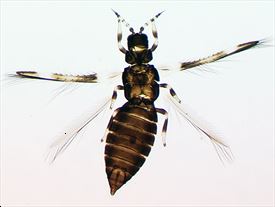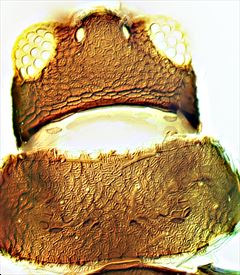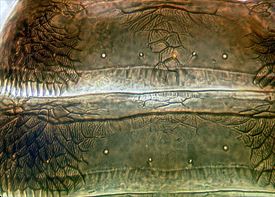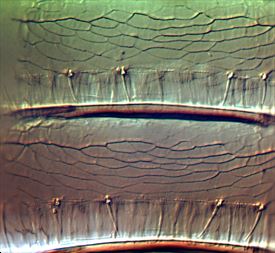Distinguishing features
Both sexes fully winged. Female dark brown; all tarsi also bases and apices of tibiae yellow; antennal segment II dark brown, III and IV yellow with apical half light brown, V yellow with apical half brown; fore wing brown, with two white cross bands, at base and sub-apically, apex dark. Antennae 8-segmented, III and IV each with a forked sense cone, VIII less than twice as long as VII. Head reticulate, not constricted at base. Pronotum reticulate, many markings within each reticle, no long setae. Metanotum irregularly reticulate, one pair of major setae close to anterior margin. Tarsi elongate but 1-segmented; hind coxae with coiled internal apodeme. Fore wing second vein with 5 to 7 setae; costal cilia shorter than costal setae. Tergite lateral thirds with almost equiangular reticulation and many markings within the reticles; VIII with craspedum medially, tooth-like microtrichia laterally; median split on X about half as long as tergite.
Male similar to female; tergite IX with three pairs of stout setae medially, median pair thorn-like; sternites III–VII with small transverse pore plate.
Related species
Caliothrips is a genus of about 22 species. Most of these are from the New World, with ten in North or Meso-America and three from Carribean Islands. Four species are from Africa and three from Asia, and two species extend into Australia. C. fasciatus is from California and, when taken in quarantine in Australia, can be recognised by the reticulate sculpture on the abdominal tergites.
Biological data
Known as the bean thrips and reputed to breed on leaves of various bean plants, but also breeding on many other unrelated plants. Adults sometimes hide inside the navels of oranges, and then cause quarantine problems with fruit imported from California into Australia and New Zealand.
Distribution data
Not recorded from New Zealand, but considered a high risk invader as it is intercepted regularly by quarantine in Australia and New Zealand. Known from Western USA, with one old record from China (Mound et al., 2011).
Family name
THRIPIDAE, PANCHAETOTHRIPINAE
Species name
Caliothrips fasciatus (Pergande)
Original name and synonyms
Heliothrips fasciatus Pergande, 1895: 391
Caliothrips woodworthi Daniel, 1904: 297
References
Hoddle MS, Mound LA, Paris DL (2012) Thrips of California 2012. CBIT Publishing, Queensland. http://keys.lucidcentral.org/keys/v3/thrips_of_california/
Thrips_of_California.html
Hoddle MS, Stosic CD & Mound LA (2006) Populations of North American bean thrips, Caliothrips fasciatus (Pergande) (Thysanoptera: Thripidae: Panchaetothripinae) not detected in Australia. Australian Journal of Entomology 45: 122–129.
Mound LA, Zhang H-R, Bei Y-W (2011) Caliothrips tongi sp.n. (Thysanoptera, Thripidae) from China, and a dubious record of North American Bean Thrips. Zootaxa 2736: 57–62






